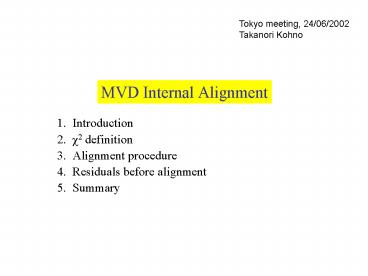MVD Internal Alignment - PowerPoint PPT Presentation
1 / 7
Title:
MVD Internal Alignment
Description:
In order to exploit the best position measurement with MVD, relative positions ... Check whether the alignment parameters have converged. If not, goto 1. ... – PowerPoint PPT presentation
Number of Views:20
Avg rating:3.0/5.0
Title: MVD Internal Alignment
1
MVD Internal Alignment
Tokyo meeting, 24/06/2002 Takanori Kohno
- Introduction
- ?2 definition
- Alignment procedure
- Residuals before alignment
- Summary
2
Introduction
- In order to exploit the best position measurement
with MVD, relative positions between MVD sensors
has to be known precisely. - Two geometries exists now. (design and survey
geometries) - With the survey geometry, position resolution of
40µm is achieved. - The aim of the alignment is to reduce the
uncertainty to about 20 µm. - This study is based on 280k cosmic events taken
in JADE hall last year. Since there were no
magnetic field, tracks were fitted with a
straight line.
3
?2 definition
Alignment parameters shift and rotations.
shift SX, SY, SZ rotation RX, RY,
RZ for every sensors.
Q
P
px, py, pz direction of the track at the
intersection point.
Since theres no measurement on z-axis ? no
sensitivity to SZ.
4
Matrix calculation
5
Alignment Procedure
- Loop over all sensors.
- Loop over all tracks and hits.
- (Fit the track by excluding particular hit.)
- Find the intersection of the track and the
sensor. - Calculate the momentum of the track at the
intersection. - Calculate the residual of the hit and the track.
- Update matrix M and vector V.
- Determine the alignment parameters (shift and
rotation). - Update the geometry of sensors all at once.
- Check whether the alignment parameters have
converged. - If not, goto 1.
In this study, tracks were fitted only once with
all hits associated with it.
6
Residual distributions
7
Some ideas for further study
- First of all, perform the iterative procedure and
see how it works. - After each iteration, see the following
quantities. - Residual distribution.
- Alignment parameters (shift and rotations).
- Maybe useful to fix the relative positions of
sensors in the same half-module. ? this enables
2D measurement for each detector element to be
aligned. - Move on to helix tracks. ? tracks with higher
momentum due to CAL and B field.































